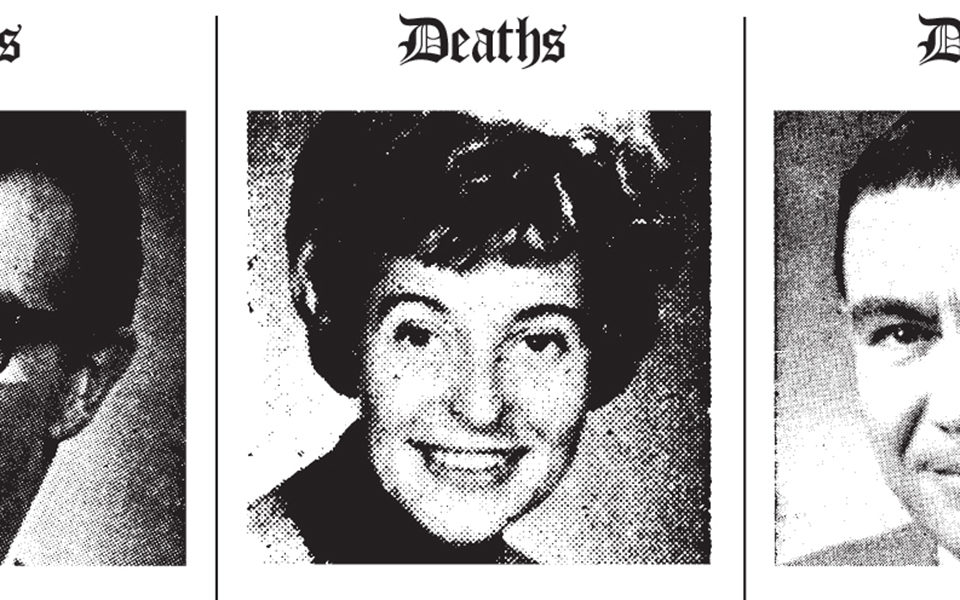
The future of professional obituary writing in Canada appears to be up in the air. Many of the country’s primary obit writers are nearing the end of their careers, and in most cases, it’s unclear who will take the reins for the next generation.
“When I leave the paper, I don’t know who will pick it up,” says Dan Nolan, the primary obituary writer for The Hamilton Spectator. Nolan has worked at the paper for 30 years and also holds the job of copy editor. He’s penned obits for extraordinary people: a Second World War prisoner of war, a woman who worked at Bletchley Park tracking German U-boats, and a Nigerian prince who left Africa and wound up living in Hamilton. Today, Nolan pitches about 90 percent of the obituaries he writes. Aside from those about notable public figures, he writes and produces the columns outside his regular working hours, getting paid per piece. “I think it’s a dying art form,” he says. “Papers are so strapped now, it’s not something they think about.”
The trade is at a crossroads. Although a vital part of the news cycle, obit writing remains a niche beat, and some writers are concerned for its future. Yet, while many predict the worst, others are confident obituary writing is stronger than ever.
In her 2012 book, Working the Dead Beat, Sandra Martin, The Globe and Mail’s longtime obituary writer who left in 2014, cited new technology, as well as modern writers’ willingness to be more forthcoming about their subjects, as reasons for what she sees as a new era of obit writing. “There is a new frankness, an unwillingness to camouflage warts under layers of unctuous hyperbole and—thanks to technology—fresh, innovative ways to augment obituaries with photographs, interviews, and even videos,” she writes.
Martin’s suggestion that the trade is still evolving is remarkable considering that obituary writing is one of the world’s longest-standing literary traditions. The practice of writing death notices can be traced back to 59 BC, when daily leaflets called Acta Diurna were distributed across the Roman Empire, containing notable news, like births and deaths.
Martin’s former colleagues at the Globe continue to dedicate significant time and resources to obits, running their one-page obituary section six days a week, usually with one to three deaths per issue.
“Obituaries are very supported, it’s recognized as part of the paper that readers love,” says Danielle Adams, the Globe’s current obituary editor. She says that the paper’s editor-in-chief, David Walmsley, is an advocate for the importance of the obituary column. “I don’t believe it’s dying, the Globe has a long tradition of carrying obituaries,” she adds.
While some freelancing occured, Martin wrote the majority of the Globe’s obituaries. When she left, the Globe didn’t hire a new full-time obit writer, instead assigning columns either to in-house journalists or freelancers.
Tom Hawthorn is one of those freelancers. He used to write a regular Globe column, but now only contributes obituaries occasionally. In 2017, Hawthorn won a Grimmy Award—handed out annually by the Society of Professional Obituary Writers—for the best longform obituary for his story about an ultra-marathoner named Al Howie.
Hawthorn has been a journalist for over 30 years, and fondly recalls the more interesting obituaries he’s written—namely Canadian wrestlers Walter “Killer” Kowalski and Maurice “Mad Dog” Vachon, and former Quebec Nordique Gilles “Bad News” Bilodeau. Although Hawthorn says many papers still run robust obituary columns, like Nolan’s, he’s not sure where the trade is headed. “I would say it peaked a few years ago from not being a very interesting art form to being a really interesting art form,” he says. “But like any other part of the industry, it’s under threat.”
The budget cuts and layoffs that have crippled the industry have forced editors to make difficult decisions about what they can do without. Despite the Globe’s dedication to the obit column, it doesn’t appear to be garnering the same support at other publications around the country.
“If I didn’t write them, nobody would,” says John Mackie, the Vancouver Sun’s chief obituary writer. Mackie, who’s been at the paper since 1984, doesn’t have the luxury of focusing solely on obituaries, and is often assigned to write about other topics. “Every person on Earth is worth a 15-inch obituary. Everybody,” he says.
Mackie doesn’t think the obit column will die off entirely at Canadian newspapers, but he’s unsure of what the quality will be like in the future due to editors who don’t recognize the importance of obits, and a younger crop of journalists who aren’t familiar with the craft. “There will be obituaries until newspapers no longer exist; the question is, how good will they be?” he asks, adding that he thinks readers still really enjoy the obituaries.
Obituary writers have to locate family and friends of the deceased, navigate libraries and historical databases for research purposes, and cobble together an accurate column that does justice to the lives of their subjects. With younger journalists not showing a great deal of interest in studying the practice, Mackie’s concerns about future quality are understandable.
With an industry in flux, the future of obituary columns in Canadian newspapers is blurry. Battle-tested writers like Nolan, Hawthorn and Mackie are keeping the columns—and their quality—afloat for the moment, but who will take over when they’ve put away their pens?
About the author
Managing Editor, Business and Audience Engagement
